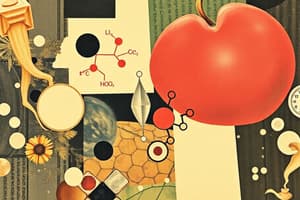Podcast
Questions and Answers
What is the primary characteristic of essential fatty acids?
What is the primary characteristic of essential fatty acids?
- They are primarily saturated fatty acids.
- They must be obtained from the diet. (correct)
- They are only found in animal products.
- They can be synthesized by the body.
Which fatty acid is a major source of omega-3 fatty acids?
Which fatty acid is a major source of omega-3 fatty acids?
- Linoleic acid
- Arachidonic acid
- Eicosapentaenoic acid (EPA) (correct)
- Stearic acid
What type of lipid is primarily involved in forming biological membranes?
What type of lipid is primarily involved in forming biological membranes?
- Triacylglycerols
- Steroids
- Phospholipids (correct)
- Glycolipids
Which lipoprotein is responsible for transporting dietary triglycerides?
Which lipoprotein is responsible for transporting dietary triglycerides?
What is one of the known roles of cholesterol in the body?
What is one of the known roles of cholesterol in the body?
What is true about triacylglycerols (TGs)?
What is true about triacylglycerols (TGs)?
Which of the following statements about lipoproteins is correct?
Which of the following statements about lipoproteins is correct?
How does the structure of sphingolipids differ from that of glycerophospholipids?
How does the structure of sphingolipids differ from that of glycerophospholipids?
Which type of fatty acids are characterized by having a double bond starting with the sixth carbon from the methyl end?
Which type of fatty acids are characterized by having a double bond starting with the sixth carbon from the methyl end?
Which type of lipid is primarily responsible for cellular energy storage?
Which type of lipid is primarily responsible for cellular energy storage?
What characteristic is NOT typical of fatty acids?
What characteristic is NOT typical of fatty acids?
Which of the following fatty acids is classified as polyunsaturated?
Which of the following fatty acids is classified as polyunsaturated?
Which function is NOT associated with lipids?
Which function is NOT associated with lipids?
What is the significance of the amphipathic nature of fatty acids?
What is the significance of the amphipathic nature of fatty acids?
Which of the following statements about complex lipids is false?
Which of the following statements about complex lipids is false?
Which clinical condition is NOT closely associated with lipid metabolism abnormalities?
Which clinical condition is NOT closely associated with lipid metabolism abnormalities?
Which type of simple lipid is primarily responsible for forming cellular membranes?
Which type of simple lipid is primarily responsible for forming cellular membranes?
The presence of double bonds in fatty acids affects which of the following?
The presence of double bonds in fatty acids affects which of the following?
What is the primary role of lipids in biological membranes?
What is the primary role of lipids in biological membranes?
Which type of fatty acid is characterized by having no double bonds?
Which type of fatty acid is characterized by having no double bonds?
Which form of lipids is primarily used for energy storage in the body?
Which form of lipids is primarily used for energy storage in the body?
Which fatty acid is known for its role as a precursor for eicosanoids?
Which fatty acid is known for its role as a precursor for eicosanoids?
What type of lipoprotein is primarily responsible for transporting cholesterol from the liver to peripheral tissues?
What type of lipoprotein is primarily responsible for transporting cholesterol from the liver to peripheral tissues?
Which of the following describes the structure of complex lipids?
Which of the following describes the structure of complex lipids?
Which physiological role of lipids is directly related to cell signaling?
Which physiological role of lipids is directly related to cell signaling?
What characteristic of fatty acids impacts their physical state at room temperature?
What characteristic of fatty acids impacts their physical state at room temperature?
Which of the following clinical conditions is closely associated with abnormalities in lipid metabolism?
Which of the following clinical conditions is closely associated with abnormalities in lipid metabolism?
Which of the following lipids is primarily involved in forming protective barriers in cellular membranes?
Which of the following lipids is primarily involved in forming protective barriers in cellular membranes?
What role do omega-3 and omega-6 fatty acids play in the body?
What role do omega-3 and omega-6 fatty acids play in the body?
Which of the following lipoproteins is primarily responsible for transporting endogenous triglycerides?
Which of the following lipoproteins is primarily responsible for transporting endogenous triglycerides?
What is a key characteristic of sphingolipids compared to glycerophospholipids?
What is a key characteristic of sphingolipids compared to glycerophospholipids?
Which statement about triacylglycerols (TGs) is incorrect?
Which statement about triacylglycerols (TGs) is incorrect?
Which of the following is NOT a precursor for cholesterol synthesis in the body?
Which of the following is NOT a precursor for cholesterol synthesis in the body?
What distinguishes essential fatty acids from non-essential fatty acids?
What distinguishes essential fatty acids from non-essential fatty acids?
Which type of lipid serves as a primary component of myelin sheaths that insulate nerve fibers?
Which type of lipid serves as a primary component of myelin sheaths that insulate nerve fibers?
What is one of the primary functions of high-density lipoproteins (HDL)?
What is one of the primary functions of high-density lipoproteins (HDL)?
Which of the following lipids is classified as a glycolipid?
Which of the following lipids is classified as a glycolipid?
What is a significant consequence of cholesterol buildup in plasma?
What is a significant consequence of cholesterol buildup in plasma?
Flashcards are hidden until you start studying
Study Notes
Definition and Classification of Lipids
- Lipids are hydrophobic organic molecules, insoluble in water but soluble in organic solvents.
- Classified into simple lipids (fatty acids, triacylglycerols, steroids) and complex lipids (phospholipids, sphingolipids, glycolipids).
Functions of Lipids
- Essential for biological membrane structure and function.
- Serve as major energy reserves via hydrocarbon chains.
- Involved in cell signaling; e.g., inositol tri-phosphate.
- Precursor for fat-soluble vitamins, steroid hormones, and prostaglandins.
Diseases Related to Lipid Metabolism
- Conditions like atherosclerosis, coronary artery disease, obesity, metabolic syndrome, and hypertension are closely linked to lipid abnormalities.
Essential Fatty Acids
- Linoleic and alpha-linolenic acids are essential dietary fatty acids, vital for skin health and membrane function.
- Arachidonic acid becomes essential when linoleic acid intake is insufficient.
Saturated and Unsaturated Fatty Acids
- Saturated fatty acids lack double bonds (e.g., palmitic, stearic acid).
- Unsaturated fatty acids have one or more double bonds (e.g., oleic, linoleic, and arachidonic acid).
Omega-3 and Omega-6 Fatty Acids
- Omega-3 fatty acids reduce triglycerides and heart disease risk; major sources include fish (e.g., EPA, DHA).
- Omega-6 fatty acids lower serum cholesterol; sources include vegetable oils and nuts.
Triacylglycerols (TGs)
- TGs are tri-esters of fatty acids and glycerol, making up the bulk of dietary lipids.
- Serve as an energy reservoir in adipocytes and provide thermal insulation.
Cholesterol and Steroids
- Steroids possess four fused ring structures; cholesterol is the primary sterol in animals.
- Cholesterol is crucial for cell membranes, bile acids, vitamin D, and steroid hormone synthesis.
- High plasma cholesterol levels are associated with cardiovascular diseases.
Phospholipids and Their Types
- Two classes: Glycerophospholipids (with glycerol backbone) and Sphingophospholipids (with sphingosine).
- Major components of cell membranes; examples include phosphatidic acid and sphingomyelin.
Glycolipids
- Comprise both carbohydrate and lipid components, including derivatives of ceramide.
- Act as blood group antigens and cellular receptors for pathogens.
Lipoprotein Transport
- Plasma lipids are transported as lipoprotein particles, consisting of lipids and apoproteins.
- Apoproteins play roles in lipid transport, enzymatic functions, and receptor ligands.
Types of Lipoproteins and Their Functions
- Chylomicrons: transport dietary triglycerides.
- VLDL: transport endogenous triglycerides.
- LDL: transports free cholesterol.
- HDL: carries cholesteryl esters.
Summary
- Lipids are critical for numerous biological functions.
- Their classification into simple and complex forms assists in understanding their roles and implications in health and disease.
Lipids Overview
- Lipids are a heterogeneous group of hydrophobic organic molecules; they dissolve only in organic solvents and are crucial for biological functions.
- Body lipids are compartmentalized in cell membranes, tissues, and plasma.
Functions of Lipids
- Essential components of biological membranes provide structure and integrity.
- Serve as major energy stores, particularly in hydrocarbon chain form.
- Play a role in cell signaling (e.g., inositol tri-phosphate).
- Constituents of fat-soluble vitamins, steroid hormones, and prostaglandins.
Diseases Associated with Lipid Metabolism
- Atherosclerosis
- Coronary artery disease
- Obesity
- Metabolic syndrome
- Hypertension
Classification of Lipids
- Simple Lipids:
- Fatty acids
- Triacylglycerols (TGs)
- Steroids (cholesterol)
- Complex Lipids:
- Phospholipids
- Sphingolipids
- Glycolipids
Fatty Acids (FAs)
- Fatty acids are long-chain carboxylic acids with amphipathic properties (hydrophilic carboxylic group & hydrophobic hydrocarbon chain).
- Insoluble in water; transported in plasma bound to proteins.
- Typical chain length ranges from C16 to C18; examples include palmitic, oleic, linoleic, and stearic acids.
Degree of Saturation in Fatty Acids
- Saturated FAs: No double bonds (e.g., lauric, palmitic, stearic).
- Unsaturated FAs: One or more double bonds (e.g., oleic, linoleic, arachidonic).
Essential Fatty Acids
- Linoleic acid and alpha-linolenic acid are essential dietary fatty acids; deficiencies can lead to dermatitis and impaired membrane function.
- Arachidonic acid becomes essential when intake of linoleic acid is low.
Omega-3 (ω-3) and Omega-6 (ω-6) Fatty Acids
- ω-3 fatty acids begin with the first double bond on the 3rd carbon from the methyl end, found in fish; they reduce triglycerides and heart disease risk.
- ω-6 fatty acids begin with the first double bond on the 6th carbon, derived from vegetable oils and nuts; they help reduce serum cholesterol.
Triacylglycerols (TGs)
- TGs, also known as fats, consist of three fatty acids bonded to glycerol and represent the majority of dietary lipids.
- Stored in adipocytes as energy reserves and provide thermal insulation.
Steroids
- Steroids are composed of a cyclopentanoperhydrophenanthrene ring structure with four fused rings.
- Cholesterol, a primary sterol, plays essential roles in cell membranes and is a precursor for bile acids, vitamin D, and steroid hormones.
- High cholesterol levels correlate with coronary artery disease and atherosclerosis.
Phospholipids
- Two classes:
- Glycerophospholipids: Contain glycerol backbone; amphiphilic with hydrophobic tails and hydrophilic heads.
- Sphingophospholipids: Contain sphingosine; important for nerve insulation and protection via components like sphingomyelin.
Glycolipids
- Comprise both carbohydrate and lipid components; derived from ceramide.
- Act as blood group antigens and cell surface receptors for pathogens.
Lipid Transport in Plasma
- Plasma lipids are transported as lipoprotein particles, comprising lipids and proteins (apoproteins).
- Types of lipoproteins:
- Chylomicrons: Transport dietary triglycerides.
- Very Low-Density Lipoprotein (VLDL): Carry endogenous triglycerides.
- Low-Density Lipoprotein (LDL): Transport free cholesterol.
- High-Density Lipoprotein (HDL): Contains cholesteryl esters.
Key Takeaways
- Lipids are vital hydrophobic molecules performing crucial physiological functions.
- Simple lipids include fatty acids, triacylglycerols, and steroids; complex lipids comprise phospholipids, sphingolipids, and glycolipids.
- Diseases can arise from abnormalities in lipid metabolism.
Studying That Suits You
Use AI to generate personalized quizzes and flashcards to suit your learning preferences.




